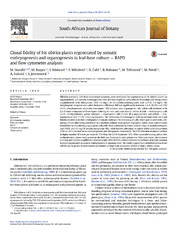Приказ основних података о документу
Clonal fidelity of Iris sibirica plants regenerated by somatic embryogenesis and organogenesis in leaf-base culture - RAPD and flow cytometer analyses
| dc.creator | Stanišić, Mariana | |
| dc.creator | Raspor, Martin | |
| dc.creator | Ninković, Slavica | |
| dc.creator | Milošević, Snežana | |
| dc.creator | Ćalić, Dušica | |
| dc.creator | Bohanec, Borut | |
| dc.creator | Trifunović-Momčilov, Milana | |
| dc.creator | Petrić, Marija | |
| dc.creator | Subotić, Angelina | |
| dc.creator | Jevremović, Slađana | |
| dc.date.accessioned | 2016-05-23T11:00:11Z | |
| dc.date.issued | 2015 | |
| dc.identifier.issn | 1727-9321 | |
| dc.identifier.uri | https://radar.ibiss.bg.ac.rs/handle/123456789/2094 | |
| dc.identifier.uri | https://s100.copyright.com/AppDispatchServlet?publisherName=ELS&contentID=S025462991400194X&orderBeanReset=true | |
| dc.description.abstract | Efficient protocols, safe from somaclonal variation, were developed for regeneration of Iris sibirica plants via organogenesis and somatic embryogenesis from leaf-base explants cultivated on Murashige and Skoog media supplemented with thidiazuron (TDZ, 1.0 mg/l) or 2,4-dichlorophenoxyacetic acid (2,4-D, 1.0 mg/l). The morphogenic response and callus formation efficiency differed significantly between 2,4-D (80.9\%) and TDZ (67\%) morphogenesis induction treatments. TDZ induced only organogenic calli, while calli obtained with 2,4-D were composed of three types differing in color and consistency: white, friable - embryogenic calli (4.5\%, 3.8 mg/explant), green, compact - organogenic calli (12.4\%, 48.4 mg/explants) and yellow - non-regenerative calli (773\%, 254.4 mg/explant). The cultivation of embryogenic calli on medium with 2,4-0 and Kinetin resulted in further development of somatic embryos (54 embryos/g of calli) which germinated with a frequency of 62\% after being transferred to a medium without plant growth regulators. Stable shoot cultures were established by transferring organogenic calli with shoot primordia to media with 0.1 mg/l alpha-naphthaleneacetic acid (NAA) and 1.0 mg/l 6-benzylaminopurine (BA), while further cultivation on media of the same composition (TDZ or 2,4-D) resulted in the reduced growth and rhizogenesis, respectively. The TDZ induction treatment resulted in higher number of shoots per explant (7.9) than the 2,4-0 treatment (43). After successful rooting and ex vitro acclimatization, plants were grown in the field and flowered to seed production. Flow cytometry, chromosome counting and random amplification of polymorphic DNA (RAPD) analysis indicated no evidence of genetic variation in plants regenerated via somatic embryogenesis or organogenesis. The results suggest that established protocols are safe for use in genetic transformation procedures or large-scale production of true-to-type I. sibirica plants. (C) 2014 SAAB. Published by Elsevier B.V. All rights reserved. | en |
| dc.description.sponsorship | Ministry of Education, Science and Technological Research, Serbia {[}ON173015, TR31019] | |
| dc.language | English | |
| dc.relation | info:eu-repo/grantAgreement/MESTD/Basic Research (BR or ON)/173015/RS// | |
| dc.relation | info:eu-repo/grantAgreement/MESTD/Technological Development (TD or TR)/31019/RS// | |
| dc.rights | openAccess | |
| dc.rights.uri | https://creativecommons.org/licenses/by/4.0/ | |
| dc.source | South African Journal of Botany | |
| dc.subject | Chromosome counting | |
| dc.subject | Flow cytometry | |
| dc.subject | Somaclonal variation | |
| dc.subject | Tissue culture | |
| dc.title | Clonal fidelity of Iris sibirica plants regenerated by somatic embryogenesis and organogenesis in leaf-base culture - RAPD and flow cytometer analyses | en |
| dc.type | article | |
| dc.rights.license | BY | |
| dcterms.abstract | Милосевиц, С.; Нинковић, Славица Б.; Станисиц, М.; Боханец, Б.; Ћалић, Душица Д.; Распор, М.; Трифуновиц, М.; Петриц, М.; Суботић, Aнгелина; Јевремовић, Слађана Б.; | |
| dc.rights.holder | © 2015, Elsevier | |
| dc.citation.volume | 96 | |
| dc.identifier.doi | 10.1016/j.sajb.2014.10.014 | |
| dc.identifier.scopus | 2-s2.0-84913555313 | |
| dc.identifier.wos | 000348959800007 | |
| dc.citation.spage | 42 | |
| dc.citation.epage | 52 | |
| dc.type.version | publishedVersion | en |
| dc.identifier.fulltext | https://radar.ibiss.bg.ac.rs/bitstream/id/5722/1-s2.0-S025462991400194X-main.pdf |

